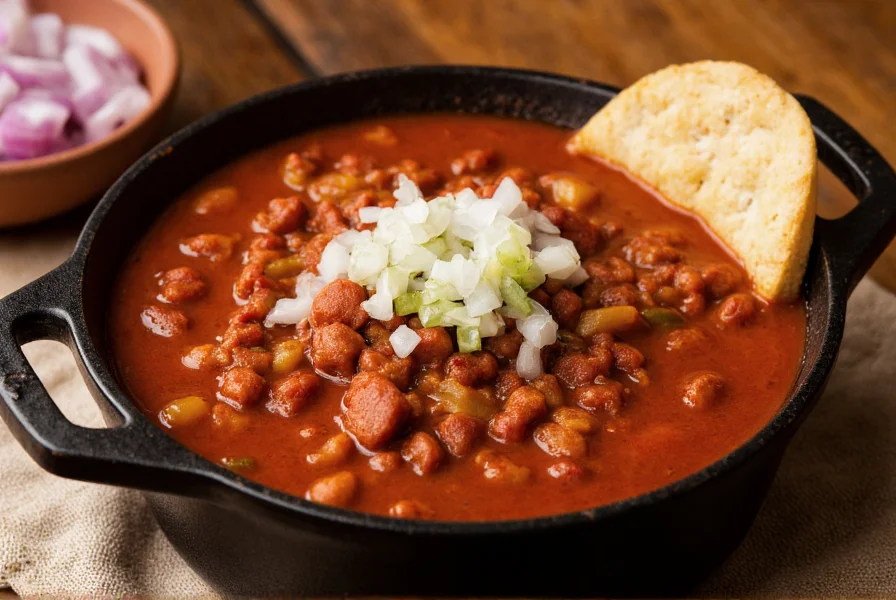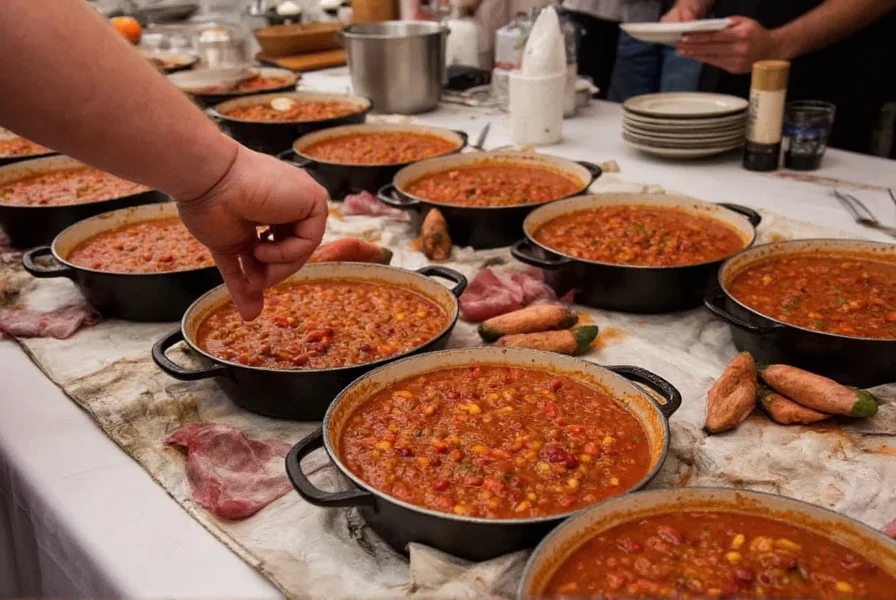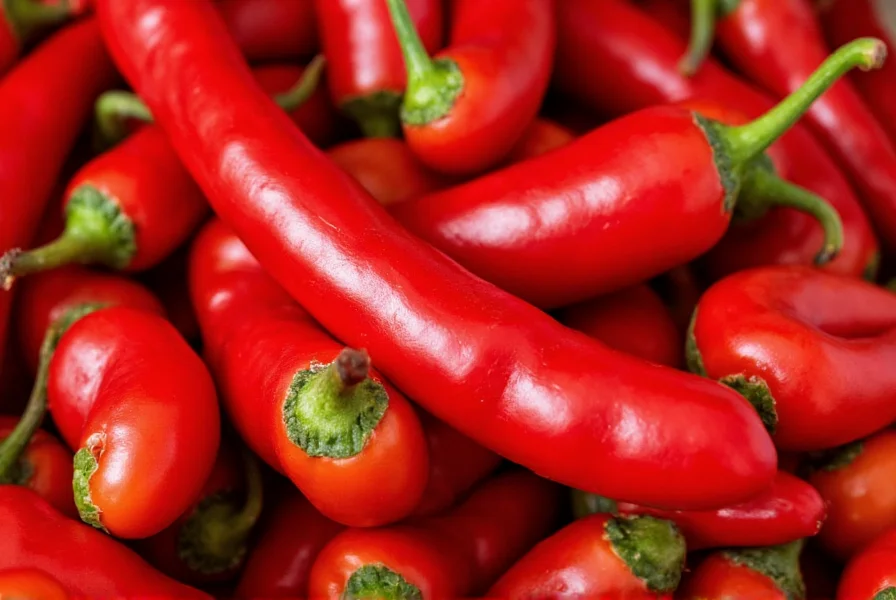Texas red chili is a bean-free meat stew made with beef and dried red chilies, originating from Texas cowboy culture. It contains no beans, tomatoes, or vegetables beyond minimal aromatics, deriving its deep red color and rich flavor from ancho, guajillo, and New Mexico chilies.
Unlike other chili varieties, authentic Texas red chili focuses exclusively on meat and chili peppers. This iconic dish emerged in the late 19th century among Texas cowboys who needed portable, protein-rich meals during cattle drives. Early versions were simple - just meat, fat, and dried chilies cooked in a cast-iron pot over open fires. The Official Texas State Legislature recognizes it as the "State Dish of Texas" with strict ingredient guidelines that distinguish it from other chili styles.

Defining Characteristics of Texas Red Chili
What truly sets Texas red chili apart is its strict ingredient list. The absence of beans is the most fiercely defended characteristic among Texas chili purists. This distinguishes it from "chili con carne" recipes found elsewhere that commonly include beans. The deep red color comes from the specific blend of dried chilies that form the foundation of the dish's flavor profile.
| Required Ingredients | Prohibited Ingredients |
|---|---|
| Beef (typically chuck or brisket) | Beans of any kind |
| Dried red chilies (ancho, guajillo, New Mexico) | Tomatoes or tomato products |
| Beef tallow or suet | Rice or other grains |
| Spices (cumin, garlic, oregano) | Vegetables beyond minimal aromatics |
Traditional Preparation Methods
Making authentic Texas red chili requires patience and attention to detail. The traditional process involves several key steps:
- Rehydrating the chilies: Dried chilies are toasted and soaked in hot water to soften them before blending into a smooth paste
- Browning the meat: Cubed beef is seared in beef tallow to develop deep flavor through the Maillard reaction
- Building the base: The chili paste is fried with spices to enhance their flavors before adding liquid
- Slow cooking: The mixture simmers for 3-6 hours to develop complex flavors and tenderize the meat
This slow cooking process allows the collagen in the meat to break down into gelatin, creating a naturally thick consistency without needing flour or other thickeners. Many traditional recipes call for cooking the chili overnight, as the flavors continue to develop and improve with time. Understanding authentic texas red chili recipe techniques reveals why shortcuts rarely produce the same depth of flavor.
Regional Variations Across Texas
While the basic principles remain consistent, Texas red chili shows interesting regional variations across the state:
- West Texas style: Features a darker, spicier profile with more cayenne pepper and less complex spice blends
- Central Texas style: Emphasizes the meat flavor with simpler spice profiles, often using just chilies, cumin, and garlic
- South Texas style: Incorporates more Mexican influences with additional spices and sometimes a touch of chocolate
- East Texas style: Slightly sweeter profile with more complex spice blends including cinnamon and cloves
These regional differences reflect the diverse cultural influences that shaped Texas cuisine. Learning about what is texas red chili made of across different regions helps understand its evolution as a cultural staple. The difference between texas chili and regular chili becomes particularly apparent when comparing these regional variations to chili recipes from other states.
Serving Traditions and Accompaniments
In Texas, red chili is traditionally served in specific ways that enhance the experience:
At chili parlors and cook-offs across the state, you'll typically find Texas red chili served in a bowl with minimal accompaniments that don't overpower the chili's flavor. Common traditional toppings include:
- Finely diced white onions
- Oyster crackers (not saltines)
- Sometimes a small dollop of shredded cheddar cheese
Unlike other regions where chili might be served over rice or hot dogs, Texas tradition keeps the focus squarely on the chili itself. Many Texans consider adding beans, tomatoes, or excessive toppings to be sacrilege that dilutes the authentic flavor. Knowing how to make texas style chili properly includes understanding these serving traditions.

Common Misconceptions About Texas Red Chili
Several myths persist about this iconic dish:
Misconception: Texas chili always includes tomatoes
Reality: Authentic Texas red chili contains no tomatoes. The acidity comes from the chilies themselves.
Misconception: All chili in Texas is extremely spicy
Reality: While some versions are hot, traditional Texas chili focuses more on complex flavor than heat. The best versions balance heat with earthy, smoky notes.
Misconception: Texas chili must include a long list of spices
Reality: Purist versions use only chilies, cumin, garlic, and salt. Many award-winning competition chilies have minimal spice profiles.
Why It's Called "Red" Chili
The "red" in Texas red chili specifically refers to the color derived from the dried red chilies that form its base. This distinguishes it from "chili verde" (green chili) which uses tomatillos and green chilies. The deep, rich red color is a visual hallmark of authentic Texas-style chili and indicates the proper use of dried red chilies rather than chili powder alone. Understanding why is it called texas red chili helps appreciate its historical significance.
Understanding the texas red chili history and its cultural importance helps explain why it's earned its place as a culinary icon. More than just a recipe, it represents a tradition passed down through generations of Texans who value its rich history and distinctive flavor profile. The texas red chili no beans rule remains central to its identity, preserving the authenticity that makes it special.
What makes Texas red chili different from regular chili?
Texas red chili contains no beans, tomatoes, or other vegetables beyond minimal aromatics. It's made exclusively with beef, dried red chilies, spices, and beef tallow. This creates a meat-forward dish with a deep red color and complex chili pepper flavor that distinguishes it from other chili varieties that commonly include beans and tomatoes.
Why is there no beans in authentic Texas red chili?
The absence of beans in authentic Texas red chili dates back to its origins among Texas cowboys and trail drivers in the 19th century. Beans weren't practical for long cattle drives as they required soaking and longer cooking times. The dish evolved as a simple meat and chili pepper stew that could be prepared with ingredients that traveled well. Today, the no-beans rule is fiercely defended by Texas chili purists as essential to the dish's identity.
What are the essential chilies for authentic Texas red chili?
Authentic Texas red chili relies on a blend of dried red chilies, primarily ancho (mild, fruity), guajillo (tangy, medium heat), and New Mexico (earthy, medium heat). These chilies are toasted and rehydrated before being blended into a smooth paste that forms the flavor foundation of the dish. While chili powder is sometimes used as a shortcut, traditional recipes use whole dried chilies for superior flavor complexity.
How long should Texas red chili simmer?
Authentic Texas red chili should simmer for a minimum of 3 hours, though many traditional recipes call for 4-6 hours of slow cooking. Some chili enthusiasts even cook it overnight. This extended cooking time allows the collagen in the meat to break down into gelatin, creating a naturally thick consistency, and lets the flavors meld and deepen. The chili often tastes even better the day after it's made as the flavors continue to develop.
What are traditional toppings for Texas red chili?
Traditional toppings for Texas red chili are minimal to avoid overpowering the chili's flavor. The standard accompaniments include finely diced white onions, oyster crackers (not saltines), and sometimes a small amount of shredded cheddar cheese. Unlike other regional chili styles, Texans typically don't serve their red chili with rice, beans, Fritos, or excessive toppings that would dilute the authentic flavor profile.
Frequently Asked Questions
What makes Texas red chili different from regular chili?
Texas red chili contains no beans, tomatoes, or other vegetables beyond minimal aromatics. It's made exclusively with beef, dried red chilies, spices, and beef tallow. This creates a meat-forward dish with a deep red color and complex chili pepper flavor that distinguishes it from other chili varieties that commonly include beans and tomatoes.
Why is there no beans in authentic Texas red chili?
The absence of beans in authentic Texas red chili dates back to its origins among Texas cowboys and trail drivers in the 19th century. Beans weren't practical for long cattle drives as they required soaking and longer cooking times. The dish evolved as a simple meat and chili pepper stew that could be prepared with ingredients that traveled well. Today, the no-beans rule is fiercely defended by Texas chili purists as essential to the dish's identity.
What are the essential chilies for authentic Texas red chili?
Authentic Texas red chili relies on a blend of dried red chilies, primarily ancho (mild, fruity), guajillo (tangy, medium heat), and New Mexico (earthy, medium heat). These chilies are toasted and rehydrated before being blended into a smooth paste that forms the flavor foundation of the dish. While chili powder is sometimes used as a shortcut, traditional recipes use whole dried chilies for superior flavor complexity.
How long should Texas red chili simmer?
Authentic Texas red chili should simmer for a minimum of 3 hours, though many traditional recipes call for 4-6 hours of slow cooking. Some chili enthusiasts even cook it overnight. This extended cooking time allows the collagen in the meat to break down into gelatin, creating a naturally thick consistency, and lets the flavors meld and deepen. The chili often tastes even better the day after it's made as the flavors continue to develop.
What are traditional toppings for Texas red chili?
Traditional toppings for Texas red chili are minimal to avoid overpowering the chili's flavor. The standard accompaniments include finely diced white onions, oyster crackers (not saltines), and sometimes a small amount of shredded cheddar cheese. Unlike other regional chili styles, Texans typically don't serve their red chili with rice, beans, Fritos, or excessive toppings that would dilute the authentic flavor profile.











 浙公网安备
33010002000092号
浙公网安备
33010002000092号 浙B2-20120091-4
浙B2-20120091-4